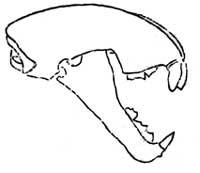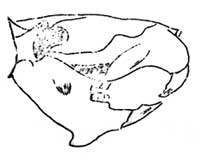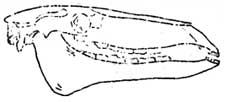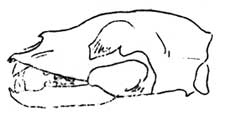

#1 Cougar - sinks its teeth in the flesh of its prey and tears it. |

#2 Beaver - has a well developed chisel-shaped set of incisors. |

#3 Mammals like the deer which crop and chew their food. |

#4 Bear are omniverous - they eat anything - and their skull and dental
display gives evidence of this. |
A group of skulls hardly make a very pleasant picture. Yet, in
addition to their serving admireably as paper weights on the desks of
medical men, they also tell us considerable about the feeding habits of
the individual or group which they characterize.
We see in the cougar skull (#1) visible evidence of the great tearing
power of this giant cat. Springing upon his prey he sinks those great
teeth into its flesh and literally rips it apart but, like all cats, he
does not stop to masticate his food well but bolts it - his molars are
not well developed. Watch your house cat, if you have one, and see how
it tears the meat you give it, crunches it hastily in its jaws a few
times and gulps. In the beaver (#2) we see an admirably well developed
set of incisors which are chisel shaped and which serve this animal well
in his work of falling trees and gathering small branches upon which is
bark, the beaver's chief food. Rodents (gnawing mammals) are
characterized by well developed incisors. Herbiverous mammals like the
deer (#3) which pull grasses and similar food free from wherever it is
growing and then grinds this food have a characteristic skull which,
like other mammals, indicates its food habits. The bear (#4) eats all
kinds of food - is omniverous - and so its skull indicates a
miscellaneous food habit. (C.F.B.)
Click to see a copy of the original
article (~108K)

